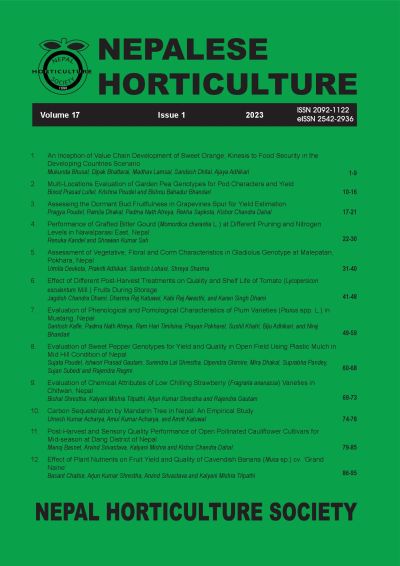An Inception of Value Chain Development of Sweet Orange; Kinesis to Food Security in the Developing Countries Scenario
DOI:
https://doi.org/10.3126/nh.v17i1.60622Keywords:
Sweet orange, Value chain, Food security, Developing CountriesAbstract
Sweet orange is one of the major citrus fruits of Nepal which is widely cultivated in mid-hills. This paper assesses the value chain of sweet oranges cultivated in the Ramechhap district of Nepal, considering its economic significance for farmers. The study adopts a qualitative research approach, utilizing key informant interviews and focus group discussions with various stakeholders. Participants were selected based on a list of producers collected from the Prime-Minister Agricultural Modernization Project (PMAMP) Ramechhap district, and the snowball method was employed to identify other actors. This study revealed that the value chain of sweet oranges in the Ramechhap district involves growers, vendors, wholesalers, retailers, and consumers as the main actors, while federal, provincial, and local agricultural service centres serve as enablers. Additionally, findings show vendors play a dominant role, in determining the per unit price and pressuring farmers to sell immediately after harvest due to limited storage capacity. Vendors are enjoying increased profit margins because they have greater bargaining power over farmers, who have inadequate storage facilities. The study suggests areas for improvement: using quality seedlings, managing nutrients effectively, and employing proper storage techniques like cold stores to prolong shelf-life and enhance quality, taste, and colour. Enhancing productivity via trifoliate rootstock, optimizing fruit quality, and extending shelf-life through improved storage facilities can substantially boost revenue for producers. Understanding the entire value chain provides insights into enhancing the overall performance of value chain actors. Further studies can explore additional dimensions of the chain in more depth.
Downloads
Downloads
Published
How to Cite
Issue
Section
License
Copyright (c) 2023 Nepalese Horticultural Society

This work is licensed under a Creative Commons Attribution-NonCommercial 4.0 International License.
© Nepalese Horticultural Society

